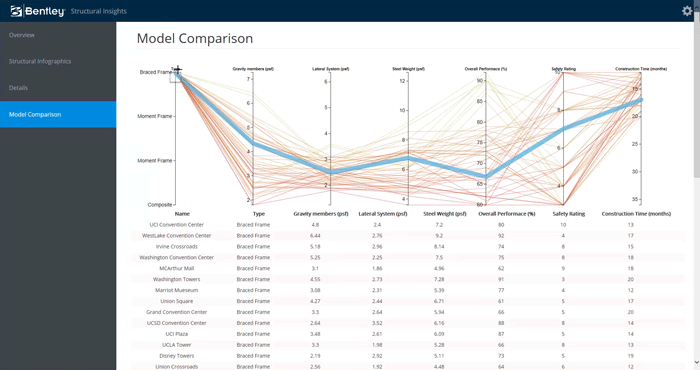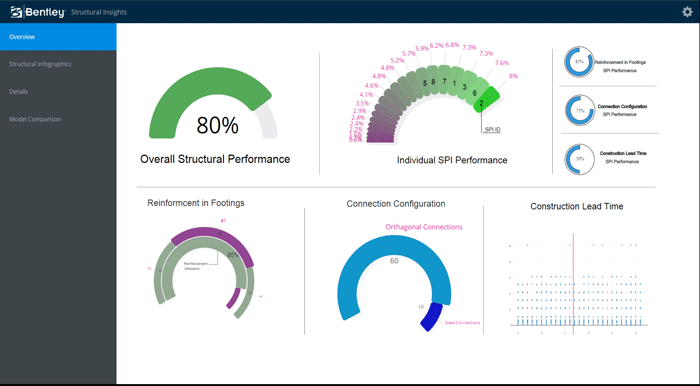A new service from Bentley will allow engineers to optimise designs for construction as well as tap into valuable engineering knowledge. By Greg Corke
Bentley Systems ProjectWise Scenario Services Connect Edition has finally arrived as an Early Access technology preview. The Microsoft Azure cloud-based ‘optioneering’ service uses large-scale simulation to help engineers find the best performing design options.
Rather than just using analysis in the traditional way to validate a handful of design options, Scenario Services is all about helping engineers explore many more alternatives and then easily compare their relative performance.
It uses the vast computational power of the cloud to run simultaneous analyses of tens, if not hundreds of different designs. Then, once complete, engineers can use the software’s web-based visualisation dashboard to compare and contrast alternatives against key ‘performance metrics’ and very quickly hone in on one or more solutions that they want to explore further.
The first analytical applications to be supported by Scenario Services will be STAAD, for structural analysis, and SACS, for analysis of offshore structures. Next year Bentley will launch an Early Access program for AutoPipe, for pipe support optimisation and RAM Concept, for post-tension geometry optimisation.
With AutoPipe and RAM Concept the software becomes even more powerful, putting engineers on the path to semi automated design. Rather than the engineer manually defining a handful of design options for evaluation, the software will use so-called genetic algorithms to automatically generate a large number of alternatives.
“Ideally what’s going to happen down the road is you will come up with valid ranges of each performance metric that you want your design to achieve and then you are going to tell the cloud to go ahead and optimise your design to achieve those goals,” explains Raoul Karp, vice-president Structural and BrIM at Bentley Systems.
In the long term Bentley plans to roll out Scenario Services to a much wider range of applications and not just limited to structural design. Optimisation will be everywhere and the performance metrics against which designs are assessed will span multiple disciplines.

Structural Insights
For structural design, Bentley has a much bigger vision for Scenario Services. A new service in development called Structural Insights will extend the scope of the service in two key ways.
Firstly it will give the engineer access to information typically held downstream that should help lead to better design decisions upstream.
Secondly, it will allow engineers to compare the performance metrics of new designs against historical projects.
Engineers typically optimise designs for strength, deflections and materials, but are not generally concerned with reducing costs relating to constructing and maintaining the building.
Structural Insights will give firms the ability to input all sorts of ancillary information that could lead to a more efficient or cost-effective design. This could be real time information about lead times on concrete and steel, but could also include more detailed information relating to construction costs, as Mr Karp explains.
“When you build a steel structure you need to use cranes to lift the material. Cranes up to a certain height can carry a certain sized beam, or certain load. Beyond a certain height you need a different kind of a crane,” he says.
“Wouldn’t it be interesting if you could feed some crane information into Structural Insights. It could run through your model and tell you — hey do you know if you were to downsize these two beams at this level, or change the framing a little bit, the contractor wouldn’t have to get a whole new crane just to lift those beams?”
The big question is would the engineer really care about this? As Mr Karp explains, with an increase in design / build and private public partnerships, the engineer is now incentivised on the cost of construction and not just that of design.
“You’re going to see more and more engineers interested in understanding when is ‘this’ material that I’m speccing in my design actually going to be available to be constructed,” he says. “This beam is going to take me two months to get from the fabricator. I’ll just swap it out and use this different beam and it can then be built quicker.”
Mr Karp adds that in a private public partnership the team also makes money from the ongoing operations — to the point that they might go for a completely different material if they know they are going to have to maintain it for 20 years.
“They might choose concrete if they know it is going to be more resistant in this environment and only have to do maintenance every five years, versus ‘I’m going to use steel here because it’s quick to get up, it’s cheaper to get up but I’m going to have to come back every three years to paint the thing.’ It changes your mentality on design.”
Structural Insights is also designed to help firms tap into engineering knowledge that exists inside (and outside) the organisation. This will help firms learn from past experiences in order to improve designs. Traditionally, this kind of knowledge is locked inside the minds of experienced engineers and often lost.
“There are a lot of younger engineers that love their software but don’t have the experience,” explains Mr Karp. “[With Structural Insights] you’re capturing the experience held in the designs and you then can feed it back to the user to the point of time that you need it the most [conceptual to mid-design phase].”
As with Scenario Services, Structural Insights will allow engineers to easily visualise the performance of different designs, current and historical, through a simple web interface.
Designs can be compared against different performance metrics. Then, if any one project shows significant savings, the engineer can open an i-model of the design and investigate what it was about that specific project that helped it get a better ‘score’.
“Users can compare on what they like,” says Mr Karp. “Say, for example, let’s just look at hospital projects, maybe the ones that are concrete flat slab and only over ten storeys. And then you’ll be down to four or five projects anyway.
“Then you can look at the other things: weight, construction time. And then you might see — this project is really doing a lot better than ours, let’s open it and see why. And then you’ll see, oh they are using a shell of a slab with post tension instead of a regular sized slab. So that would be how I would expect engineers would start to learn.”
In order to get the most out of the system, firms will obviously need to invest time populating it with historical data. Users will be able to add information, such as project type, the function of the building, geographic locations, as well as structural data. Obviously this needs to be easy to do, so Bentley is currently looking at ways to help streamline the process.
Bentley has an ambitious vision for Structural Insights in that it hopes it will become an industry benchmark. “The expectation and desire is that at some point we will get our users to commit to saying I don’t want to just compare to my organisation’s projects, I want to compare to every other project done by every other organisation in this area,” he says.
Knowledge sharing on this scale is unprecedented and it will be interesting to see how the open market embraces it. Collaboration between local government agencies, however, will be a much easier sell.
Should Bentley get firms to buy into its vision, the benefits to the construction industry as a whole could be huge. Structural Insights will be available in limited access in March 2016.
This article is part of an in depth technology feature on Bentley Systems.
Read Bentley merges design with reality.
If you enjoyed this article, subscribe to AEC Magazine for FREE






